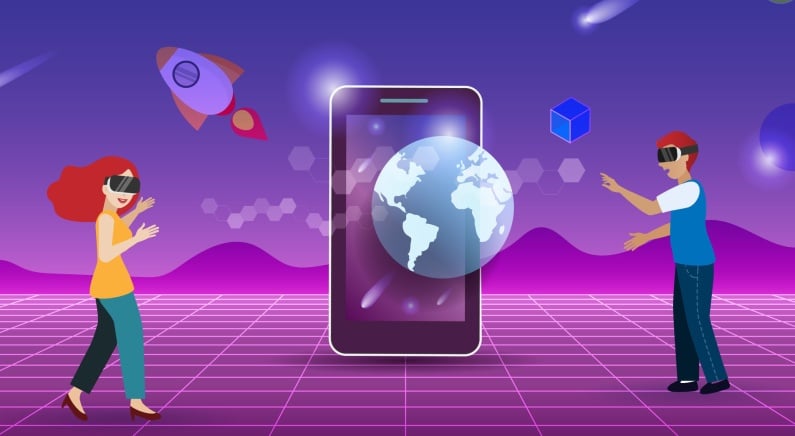Metaverse News, Events, and Developments For January 2022

Metaverse is the world’s latest craze and the apparent direction the internet will take. Consequently, everyone’s jumping on the bandwagon. Here are the Metaverse events that marked January 2022.
Terraform Labs Devotes $4 Billion For Terra Development
Terraform Labs, the company producing the Terra blockchain, will provide 50 million LUNA (over $4 billion) as part of a round of funding for the newly formed Luna Foundation Guard (LFG), a not-for-profit organization. As of right now, the second phase will be focused on improving the project ecosystem and increasing the stability of Terra USD (UST).
Its leadership is ensured by an independent board of governors that includes experts in the crypto industry and leaders of crypto companies such as Terraform Labs CEO Do Kwon. In addition, the organization will grow in the future to include other participants in the Terra ecosystem.
Also, the organization plans to provide grant awards to developers, researchers, and members of the community for their “bold ideas to benefit the Terra economy.” The organization divided the application process into three categories:
- Developing open-source technologies is essential for the advancement of the industry
- Education and research are integral to each other
- Development of communities
LFG will receive 50 million LUNA from Terraform Labs as seed funding. It is expected that the transaction will take place on January 22. For the public assurance of transparency, the hash of the data will be published in the public domain.
According to DeFi Llama, since the market began in September 2016, the blocked funds (TVL) value has reached $18,64 billion in DeFi-apps on Terra. Based upon our indicator, Blockchain Protocol ranks second in the list of the largest ecosystems based on the number of applications it supports, second only to Ethereum.
Based on CoinGecko‘s report, UST stablecoin’s market capitalization has gone up by more than 5,000% over the last 12 months, to reach $10.86 billion since its launch.
The recent news was that Terraform Labs raised $150 million in July 2021 from various investors, such as Arrington XRP Capital, Pantera Capital, Galaxy Digital, and BlockTower Capital.
Walmart Enters Metaverse
As reported by The Wall Street Journal on November 19, 1997, Walmart, America’s largest retailer, has filed a flurry of new trademark applications with the United States Patent and Trademark Office (USPTO) to sell virtual goods, including electronic goods.
Another application not related to its metaverse indicated that it is working hard to establish its cryptocurrency and non-fungible tokens (NFTs).
According to a report by CNBC, the report indicated that seven trademark applications were submitted in December 2021. In addition, Walmart has been exploring new ways to promote virtual shopping to “continuously explore new technologies and technologies.”.
“Some ideas are developed into products or services available to customers. In addition, the company told the publication that some products will be tested, iterated, and adapted.
As part of Walmart’s digital advertising project, christened “Walmart Connect,” the company also filed three patent applications. Bloomberg reports that the company filed for “Verse to Store,” “Verse to Curb,” and “Verse to Home” in the shopping category.
Walmart has been making some moves in the crypto space since its Chief Financial Officer Brett Biggs told the media in December that the company had plans to allow customers to pay in crypto cryptocurrencies like Bitcoin and Ethereum as long as the demand from the public is high.
Litecoin jumped 30 percent in September 2017 following a hoax news release that claimed Walmart would begin accepting payments in the cryptocurrency. The announcement triggered the cryptocurrency by 30 percent before the retail giant admitted that the news release was fake.
Samsung Opens Decentraland Metaverse Store
Recently, Samsung opened a store in the virtual world of Decentraland as a part of its impending expansion into the world of the Metaverse.
As the company announced in a press release, an all-new Samsung 837X virtual store is set to open for business for a limited time from today. The company said that the dedicated virtual store is themed after Samsung’s flagship 837 store in New York.
It is expected that Decentraland users will have access to an “experiential playground” in which they will be invited to complete quests and earn NFT rewards.
There will be three main areas of the experience, the Connectivity Theater (which showcases news from Samsung’s stage at CES 2022), Sustainability Forest, an interactive tree journey to highlight Samsung’s sustainability initiatives, and Customization Stage which lets you personalize the experience.
On June 29, NFT badge holders will be entered into a raffle in which they can win Samsung branded swag for their Decentraland avatars during the in-metaverse dance party hosted by DJ Gamma Vibes from the physical 837 stores.
According to Michelle Crossan-Matos, Senior Vice President of Corporate Marketing and Communications at Samsung Electronics America, “The potential of the metaverse is to facilitate the creation of virtual experiences that could not be achieved through any other means,” she said in a statement accompanying the release.
A few months after the company’s launch in Decentraland, 837X plans to expand its presence to other metaverse platforms after launching in Decentraland.
NBA’s Brooklyn Nets Join the Metaverse
With the Brooklyn Nets becoming the first professional sports team to enter the metaverse, there’s no doubt that they take the sports world by storm. This week, the NBA team introduced a new innovative video system that creates cutting-edge 3D renderings in seconds, dubbed the “Metaverse.”
By offering the metaverse to fans of the Nets, the team hopes to offer them the chance to enjoy a futuristic way to watch the NBA. “Netaverse” is designed to simulate a 360-degree virtual reality experience by using over 100 high-resolution cameras positioned around the court. Canon’s Free Viewpoint System then takes the visual input and uses it to successfully produce real-time, detailed 3D models and images of every player on the court. So if you were to place the fans anywhere along the sidelines, behind the nets, or even in the middle of the court, you might be able to catch every angle of the match from where you were seated.
As well as becoming the first team in the NBA to offer fans a 360 degree VR experience, the Brooklyn Nets are the first pro sports team in the United States to use this technology. In addition, these cameras have been installed at the Barclays Center, the first stadium to install them.
Microsoft Buys Activision Blizzard as an Entry Ticket to Metaverse
A shockwave spread through pretty much every corner of the technology industry when Microsoft announced its plans to acquire game publisher Activision Blizzard. It will be Microsoft’s largest-ever acquisition as it represents the company’s first time acquiring a company for more than $68 billion ($95 per share). The five-year agreement will create the world’s third-largest gaming company after Sony and Tencent. Microsoft Gaming, the new division of the company, is going to sit at the base of the organization that will integrate the company’s PC, console, and mobile gaming brands, as well as one other very important – and, perhaps, even more important – project: that of the company entering the ‘metaverse.’
There are plenty of questions that need to be answered with any deal this size (two and a half times the size of the $25 billion deal the company made to buy LinkedIn), but there are some big ones that are worth asking. Microsoft’s willingness to spend so much money on a games publisher is an interesting question. What does Microsoft’s willingness to spend so much money on games have to do with the metaverse? In addition, what is the significance of Activision Blizzard’s presence in the metaverse?
To make this deal even more intriguing, let me fill you in on a few bits of background about it, in addition to outlining the massive price tag.
As of late, there has been a lot of bad buzz surrounding the company that is now known as “Activision Blizzard.” However, it deserves special mention that, before mid-2021, this company was known mainly for its AAA franchises, like Blizzard’s World of Warcraft and Overwatch series, as well as Activision’s massive hits, such as Call of Duty, and mobile games, such as Candy Crush, which are being produced under their King brand.
As stated here, in July 2021, the Department of Fair Employment and Housing filed a lawsuit against Activision Blizzard in response to “numerous complaints about unlawful harassment, discrimination, and retaliation.”. According to the agency, Activision Blizzard had a corporate culture in which female and minority workers were sexually harassed, marginalized, and underpaid and were rejected, dismissed, or stifled in their attempts to complain about the misconduct. In addition, a Wall Street Journal report asserts that the current CEO of Activision Blizzard, Bobby Kotick, was aware of sexual misconduct allegations against him for years before he was appointed.
Since that time, Activision’s Blizzard unit has seen many company changes, including the departure of Jen Oneal, Blizzard’s co-director, who claimed she was paid less than her male counterpart Mike Ybarra while specifically chosen to help clean up the toxic workplace culture within the company. In addition, the US Securities and Exchange Commission (SEC) launched an investigation into how the company handled employee complaints about sexual harassment and misconduct; several high-ranking executives have left the company; several major sponsors have stopped funding the company, and numerous employee protests over the lack of progress in addressing these issues have taken place. As a result of this final element, thousands of Activision Blizzard employees walked out of the office, 700 of whom signed a petition which called for the removal of CEO Bobby Kotick.
As a result, you might be wondering why Microsoft might still be interested in the project after all this happened.
It would appear that the answer to the question is two-fold: Xbox Game Pass and the metaverse. Moreover, it appears that the Windows maker sees these factors as having a great deal of significance not just to its future in the gaming space but also to its future in industries such as entertainment, communication, and the many other areas that the metaverse will impact.
Metaverse Startup Cyber Raises $6.7M
The past three months have been hectic in the metaverse for Cyber, a startup that provides a virtual showroom for non-fungible tokens (NFTs).
Cyber has just released a new feature that will allow users to connect through a portal containing ‘doorways,’ each pointing to a different user curated gallery. An announcement was made on the firm’s Twitter account on January 10, teasing the release of the portal.
Rayan Boutaleb, Cyber’s founder, reports to The Block that the company raised $6.7 million in November through a venture led by Variant, the ‘ownership economy’ seed-stage investor that led the $110 million fundraise (including its own) in October.
Additionally, a bevy of top-name NFT collectors also invested – among them Cozomo de’ Medici, Joey Colombo, Product Hunt Founder Ryan Hoover, Scott Belsky, Adobe Chief Product Officer, Not Boring Founder Packy McCormick, Ansible Founder Erick Calderon, as well as the pseudonymous trio of 6529, DeeZe and Gmoney. The investment firms, Three Arrows Capital and TCG Capital Management, also took part in the funding round.
Boutaleb did not disclose the valuation of the startup. Cyber’s mission, he says, is to allow people to deploy immersive spaces of any size, regardless of their scale. He plans to use the raise proceeds to hire primarily and remain “completely product-driven.”.
Disney Readies a Metaverse of its Own?
With the entertainment giant exploring headset less augmented reality, visitors to Disney parks may soon be riding through the metaverse.
During the final week of December, Disney Enterprises was approved for a patent for a virtual-world simulator. According to US Patent Office, this technology would enable 3D images and virtual effects on a physical surface.
Instead of being designed for mass entertainment, it would allow the projections to be individualized for each park visitor instead of being designed for mass entertainment. So it is possible, for instance, that one family may see Mickey Mouse greeted by a hot dog stand, whereas another group may meet Princess Belle and Cinderella.
As Disney’s CEO Bob Chapek pointed out during its quarterly earnings call, the technology is aligned with the brand’s mission to tell stories based on a “three-dimensional canvas.”
In essence, our efforts to date are just the prelude to a time when we’ll be able to connect the physical and digital worlds even more closely, enabling Disney to tell stories without boundaries within its universe, Chapek said.
A company official told The Los Angeles Times that Disney has “no current plans” to use the simulator. However, they explained that Disney files hundreds of patents every year to explore developing technologies. Insider requested a comment from Disney but did not respond immediately.
Wearable AR devices will require “burdensome sanitation procedures” during the COVID-19 era, citing the patent as evidence of the simulator’s ability to create shared virtual-world experiences without requiring a headset or mobile device, which “can be costly and inconvenient to wear.” The patent also highlights the simulator’s ability to create shared virtual-world experiences without a headset or mobile device.
Adidas and Prada Announce Metaverse Collab
Adidas Originals and Prada, two international brands renowned for their relentless progressive approach to innovation and originality, released the Adidas for Prada Re-Nylon collection that boldly enters the digital realm as part of their revolutionary collaboration.
The Adidas for Prada source project is a pioneering NFT collaboration, the first of its kind that will include art generated by users and created by their own hands. As part of the project, participants from across the fashion, design, and cryptocurrency worlds will work together to create an enormous digital artwork inspired by the physical Re-Nylon collection.
Nike and Prada will invite their collective audiences to participate in the open-Metaverse NFT project by contributing unique anonymous photographs. In addition, thousands of artworks generated by communities will be minted into NFTs and collected into a single mass-patchwork NFT designed by Zach Lieberman, an artist, and creator of renowned creative code. Taking part in Adidas for Prada re-source NFT is a collaborative endeavor in the true sense of the word. Participation is free of charge, with contributors receiving full ownership rights over the tiles.
A partnership between Adidas and Prada will allow Lieberman’s final NFT to be auctioned on SuperRare, a pioneering market for curated NFT art. Almost all the proceeds from the auction go directly to Slow Factory. This non-profit organization creates an educational environment to drive meaningful solutions and create more inclusive communities.
Adidas Originals and Prada are putting the power of the digital world to good use by leveraging the wide availability of NFTs and Web3 technology to reward participation in a new form of collective rooted in ownership, authenticity, and community. During the development of the project for the Polygon network, Adidas and Prada collaborated with Polygon Studios to build the project.
It is unquestionably a community-driven organization; relentlessly innovative. Adidas and Prada’s re-source project stands out as the latest collaboration between the two brands from a metaverse perspective.
Cardano and Pavia Debut in Metaverse as Virtual Land Investment Skyrockets
There has been much buzz surrounding the metaverse since its reveal. It is one of the most talked-about concepts in every crypto industry. Cardano is the latest project in a long list of projects that are looking to stake their claim to the multi-trillion dollar metaverse industry.
Cardano has made its debut in the metaverse a couple of months after its smart contracts were activated. With the launch of Pavia on the company’s blockchain, Dano has become one of the first coins in the virtual space.
Thousands Now Own Virtual Lands in the Pavia Metaverse
The project Pavia is a play-to-earn gaming platform that uses non-fungible tokens (NFTs) to fund gameplay. PAVIA is a P2P project, which means that players will explore the digital world of Pavia while earning and spending PAVIA tokens, which are the in-game currency.
Licensed under the Cardano protocol, Pavia boasts of being the “first Cardano metaverse.” Pavia includes 100,000 parcels of virtual land within the Cardano metaverse. In November of 2021, there were 31,000 land parcels sold, of which 29000 were sold in October and 29000 in November.
There are several different plots of land for sale in Pavia, with the starting price being around $1,000 and going up to $1.26 million. According to Pavia, there are 40,000 plots still available for sale, and they will be sold in the first quarter of 2022.
Also, Pavia Security has announced that it will add liquidity to Cardano decentralized exchanges [DEXs] and conduct an investigation for cross-chain liquidity in the first quarter of 2022.
Pavia’s launch comes with a lot of hype and expectations. Many call Pavia the next Decentraland, except it uses the more environmentally friendly Cardano blockchain to replace Ethereum’s blockchain.









